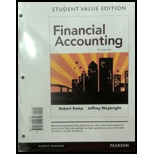
Financial Accounting, Student Value Edition (4th Edition)
4th Edition
ISBN: 9780134114811
Author: Robert Kemp, Jeffrey Waybright
Publisher: PEARSON
expand_more
expand_more
format_list_bulleted
Concept explainers
Question
Chapter 7, Problem 6SE
To determine
Match the given terms with its definition.
Expert Solution & Answer
Want to see the full answer?
Check out a sample textbook solution
Students have asked these similar questions
Given answer financial accounting question
What is the true answer? ?
None
Chapter 7 Solutions
Financial Accounting, Student Value Edition (4th Edition)
Ch. 7.A - Prob. 1SECh. 7.A - Prob. 2SECh. 7.A - Prob. 3AECh. 7.A - Prob. 4AECh. 7.A - Prob. 5BECh. 7.A - Prob. 6BECh. 7.A - Prob. 7APCh. 7.A - Prob. 8APCh. 7 - Which duties should be segregated in the...Ch. 7 - Prob. 2DQ
Ch. 7 - Prob. 3DQCh. 7 - Why does the allowance method of accounting for...Ch. 7 - Prob. 5DQCh. 7 - Prob. 6DQCh. 7 - Prob. 7DQCh. 7 - How would the net realizable value of Accounts...Ch. 7 - Prob. 9DQCh. 7 - Prob. 10DQCh. 7 - Prob. 1SCCh. 7 - Prob. 2SCCh. 7 - Prob. 3SCCh. 7 - Prob. 4SCCh. 7 - Prob. 5SCCh. 7 - Prob. 6SCCh. 7 - Prob. 7SCCh. 7 - Prob. 8SCCh. 7 - Prob. 9SCCh. 7 - Prob. 10SCCh. 7 - Prob. 11SCCh. 7 - Prob. 12SCCh. 7 - Prob. 1SECh. 7 - Prob. 2SECh. 7 - Prob. 3SECh. 7 - Prob. 4SECh. 7 - Prob. 5SECh. 7 - Prob. 6SECh. 7 - Prob. 7SECh. 7 - Prob. 8SECh. 7 - Prob. 9SECh. 7 - Prob. 10SECh. 7 - Prob. 11SECh. 7 - Prob. 12SECh. 7 - Prob. 13SECh. 7 - Prob. 14SECh. 7 - Prob. 15SECh. 7 - Quick ratio (Learning Objective 7) 510 min....Ch. 7 - Prob. 17SECh. 7 - Prob. 18AECh. 7 - Prob. 19AECh. 7 - Prob. 20AECh. 7 - Prob. 21AECh. 7 - Prob. 22AECh. 7 - Prob. 23AECh. 7 - Prob. 24AECh. 7 - Prob. 25AECh. 7 - Prob. 26AECh. 7 - Prob. 27AECh. 7 - Quick ratio and current ratio (Learning Objective...Ch. 7 - Prob. 29AECh. 7 - Prob. 30BECh. 7 - Prob. 31BECh. 7 - Prob. 32BECh. 7 - Prob. 33BECh. 7 - Prob. 34BECh. 7 - Prob. 35BECh. 7 - Prob. 36BECh. 7 - Prob. 37BECh. 7 - Prob. 38BECh. 7 - Prob. 39BECh. 7 - Quick ratio and current ratio (Learning Objective...Ch. 7 - Prob. 41BECh. 7 - Prob. 42APCh. 7 - Prob. 43APCh. 7 - Prob. 44APCh. 7 - Prob. 45APCh. 7 - Prob. 46APCh. 7 - Prob. 47APCh. 7 - Prob. 48APCh. 7 - Prob. 49BPCh. 7 - Prob. 50BPCh. 7 - Prob. 51BPCh. 7 - Prob. 52BPCh. 7 - Prob. 53BPCh. 7 - Prob. 54BPCh. 7 - Prob. 55BPCh. 7 - Continuing Exercise In this exercise, we continue...Ch. 7 - Prob. 1CPCh. 7 - Prob. 1CFSAPCh. 7 - Prob. 1EIACh. 7 - Prob. 2EIACh. 7 - Prob. 1FACh. 7 - Prob. 1IACh. 7 - Prob. 1SBACh. 7 - Prob. 1WC
Knowledge Booster
Learn more about
Need a deep-dive on the concept behind this application? Look no further. Learn more about this topic, accounting and related others by exploring similar questions and additional content below.Similar questions
arrow_back_ios
SEE MORE QUESTIONS
arrow_forward_ios
Recommended textbooks for you
 Intermediate Accounting: Reporting And AnalysisAccountingISBN:9781337788281Author:James M. Wahlen, Jefferson P. Jones, Donald PagachPublisher:Cengage Learning
Intermediate Accounting: Reporting And AnalysisAccountingISBN:9781337788281Author:James M. Wahlen, Jefferson P. Jones, Donald PagachPublisher:Cengage Learning


Intermediate Accounting: Reporting And Analysis
Accounting
ISBN:9781337788281
Author:James M. Wahlen, Jefferson P. Jones, Donald Pagach
Publisher:Cengage Learning
Accounts Receivable and Accounts Payable; Author: The Finance Storyteller;https://www.youtube.com/watch?v=x_aUWbQa878;License: Standard Youtube License